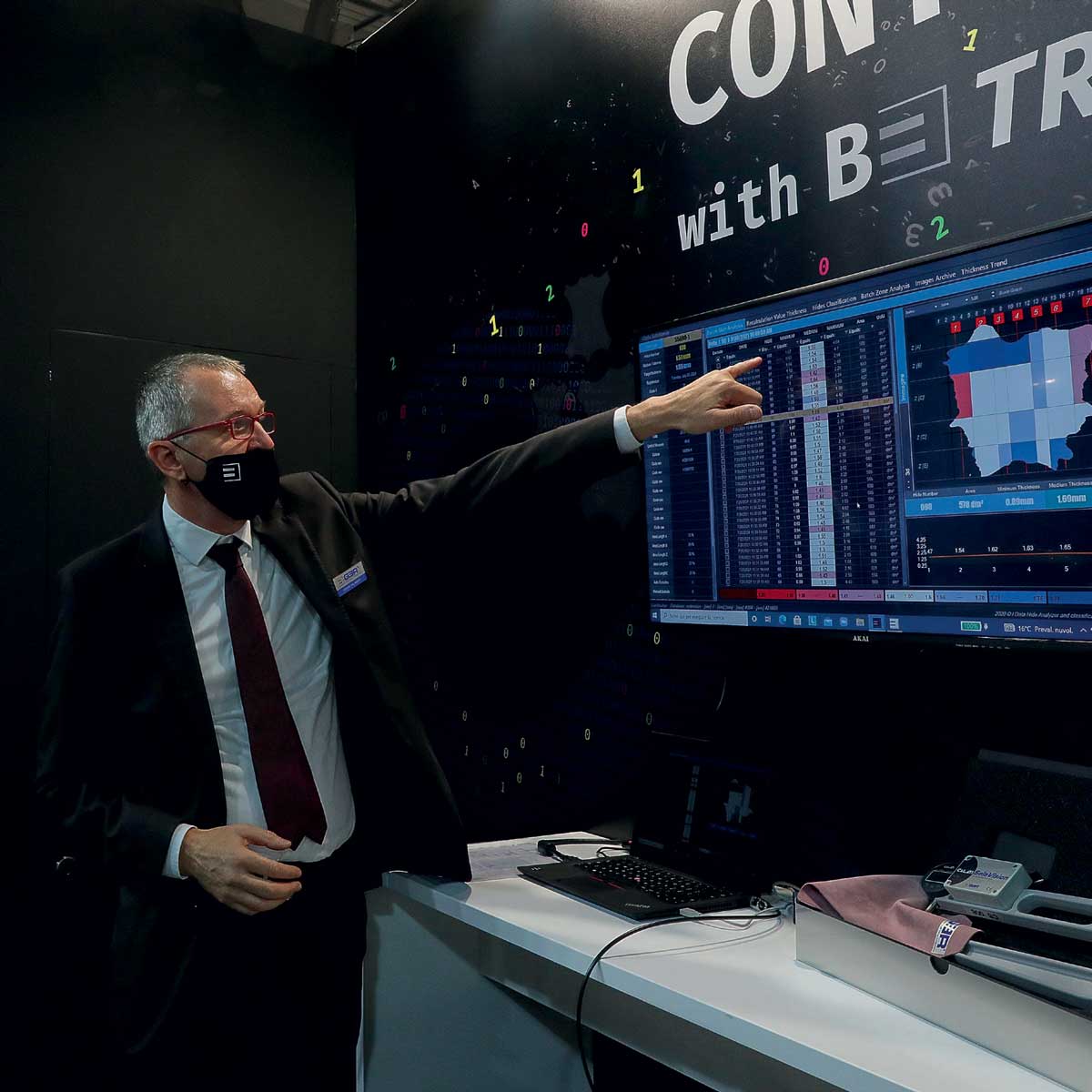GER ELETTRONICA, born as a specialist in leather surface measuring machines and spray paint economizers, has launched an important system dedicated to the digital transition of the tannery
“The innovation we brought to this edition is what we can define the evolution of the species.” With these words, said during the Tanning Tech Exhibition last September, Cesare Dal Monte, General Manager of GER ELETTRONICA, based right next to the tanning district of Arzignano (Montecchio Maggiore, Vicenza province), explains the new strategy of the company. At the fair, the first to be held after almost a two-year stop, GER’s stand was far one of the most crowded and visited thanks to the technological innovations and innovative systems that were presented.
“Such evolution of the species – Dal Monte specifies – comes from our own’s: from a specialist in leather surface measuring machines and spray paint economizers, we are now leading the tannery in the much-needed digital transition. With this regard, we have already developed, supported by our technical office, business intelligence systems, through which we read all the physical features of the hide and send them to specific software, called I.DATA, that lets us check the figures on screen so to monitor the situation. This ground-breaking system has been reproduced here at the fair and has become, without false modesty, one of the attractions of the entire fair: undoubtedly, displaying a large number of data concerning a batch or a single hide, is a very attractive and interesting feature. In other words, we digitize and scan the hide, releasing a kind of data passport to be used in future processing. We have also devised a new system for a complete leather traceability, which we have called BE.TRACE, and it’s made up of specific hardware and software that are able to read a very large series of codes.”
What does traceability mean to you?
“We see it in two different ways: ethical traceability, obtained through several certifications, that means marking the hide so to tell the customer about life, history and characteristics of the animal. At the moment, this aspect only marginally affects the tannery, but is becoming important for the consumers world. If, on the other hand, a tannery sees traceability as a way to control its own process, here comes industrial traceability, which is much more complex and is needed to understand how production is carried out. In this case, there’s a very simple and rapid way to trace production: by collecting all data in a large database, equipped with advanced technology, come a series of information that guarantee traceability and an always available archive. Through this, one can understand how the leather is manufactured and what mistakes have been done, in order to subsequently improve the process.”
Does all this represent the future of the leather industry for GER ELETTRONICA?
“As a matter of fact, this is only the beginning, given that we are moving more and more towards the world of data, more precisely of Big Data, seen as ‘great masses of information’. What we are creating today is a system of sensors that read and interpret the leather with the aid of artificial intelligence, flanked by devices that give a “name and surname” to each single piece, providing an archive on a powerful database. Finally, using the software we analyze how the tannery has actually worked: this helps entrepreneurs, among other things, to reduce the environmental impact, to be more sustainable and to avoid wasting resources unnecessarily. In other words, the final goal is to gradually create an increasingly performing system.”
Can you explain how the BE.TRACE system works?
“The system can be inserted in the production chain, wherever the customer needs to identify the leather code. Since in the world of tannery, at present, there is no single coding system, we have created a flexible system able to “read” different types of code, thanks to the use of an artificial vision algorithm. The system can switch from one technology to another by connecting them in the database, in order to keep the tracing of the original code. Alongside the tracing system we have developed the I.DATA which is a software equipped with Business Intelligence technology. Thanks to the use of sensors located along the production chain that takes the data “read” on the leather, I.DATA is able to visualize every single leather by analyzing how it has been processed along the production chain. This software is very useful in the post-production phase for the process optimization.”
What kind of example did you bring at the fair?
“That of a batch consisting of 88 hides, a good quantity: at the end of the measurement of the entire batch, 47 hides complied with the required thickness, 32 were slightly thinner, respectively 6 and 3 other pieces featured slightly out-of-standard thicknesses; all of this was displayed in an intuitive way thanks to different colors. Thanks to the BE.TRACE, which will be developed specifically for each customer, it will be possible to use the database related to the wet-blue leather, to the crust and the finished leather, so to monitor the whole process, from start to finish.”
What economic balance can be done for GER ELETTRONICA?
“The pandemic still affects economy and trade, especially at an international level. This year, the Italian market has grown, Industry 4.0 is undoubtedly boosting up the sector, signs are clear: on the domestic market, our share on the total turnover went from 25-27% to 35-37%, registering a 33% growth. As far as the world markets are concerned, at the moment the Far East is still lacking, due to travel limitations that preclude the opportunity to offer products in China and in the rest of Asia. As far as we are concerned, the Northern European market is moving a bit, but the international scenarios are still uncertain in view of 2022.”


Cesare Dal Monte
